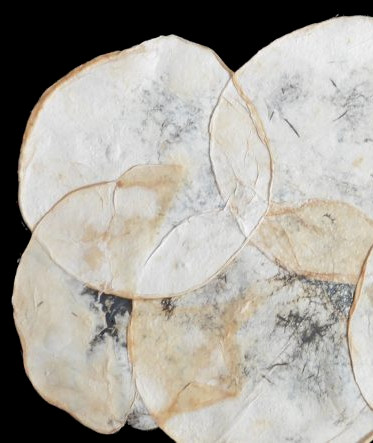As explained in the article Affective Materialities– New Materialism and material agency, the philosophical perspective of ‘new materialism’ is especially relevant in relation to the use of new bio-based materials or bacteria to develop or grow textiles or fashion objects. In the context of all social, environmental, economic and political problems of the current fashion industry, there is a great urgency to deal in a more ethical way with (raw) materials, and to question their value and meaning. The interaction between the creative, conceptual and aesthetic approach of designers and the fundamental scientific knowledge on sustainable materials is essential to develop innovative materials, insights and solutions. More and more designers are actively exploring the possibilities of new kinds of ‘living materials’ materials (e.g. materials from mycelium, growing colours from bacteria, textiles
from algae) for applications in the fields of fashion, textile and design.
The research project The Future of Living Materials, a collaboration of the ArtEZ Centre of Expertise Future Makers and Wageningen University & Research, that aims to investigate and develop ‘living’ materials, natural waste (living leather, living waste) and natural principles (living systems) and, therefore, to contribute for the transition to a more sustainable fashion system. The project consists of 5 sub-projects: Living Systems, Living Skin, Living Leather, Living Waste and Living Colors.
Living Systems focuses on natural (raw) resources, (living) materials and diverse functional principles that by mimicking biological shapes, processes and systems can be a way to contribute to a sustainable, circular future.
Designer: Lilian van Daal.
In a mutual effort, designers and scientists are currently working on the development of three new materials. Living Leather can function as an alternative to the significant environmental impact caused by natural leather. It is made by fruit waste, a natural renewable material daily discarded in large quantities, serving as a raw material for new materials such as Mylium, Fruitleather and Piñatex.
Designers: Luc Aarts, Iris Houthoff
Living Skin focuses on ‘second-skin’ materials. It offers a high personalisation of textiles and clothing due to the ‘behaviour’ of living materials such as mycelium, kombucha and algae that when worn on the skin of the human body gain different shape according to the body of the wearer.
Designers: Aniela Hoitink, Emma van der Leest and Karin Vlug
Living Waste aims to transform the vast quantities of waste discarded by people in raw materials. An example is the production of naturally degradable yarns or filaments for 3D printing derived from cellulose that can be extracted from agricultural and industrial waste. Bone waste from the meat industry, for instance, has been used for centuries for a high quality of ceramic production.
Designer: Nienke Hoogvliet
Designers have been experimenting with pigments and colors of living organisms, such as plants, algae and bacteria to dye textiles. Living Colors, another research project The Future of Living Materials, focuses on the development of new ways of colouring through bio-dying and the preservation of a circular life of colors through upcycling dyes and residual ink. These processes also contribute to the creation of a diverse color palette pointing towards new aesthetics possibilities brought out through bio-design.
Designers: Aliki van der Kruijs, Laura Luchtman and Ilfa Siebenhaar
To know more about the project, please visit futuremakers.artez.nl.
Read more about the project on page 206 at issuu.com/stateoffashion and at thevoiceoffashion.com.
